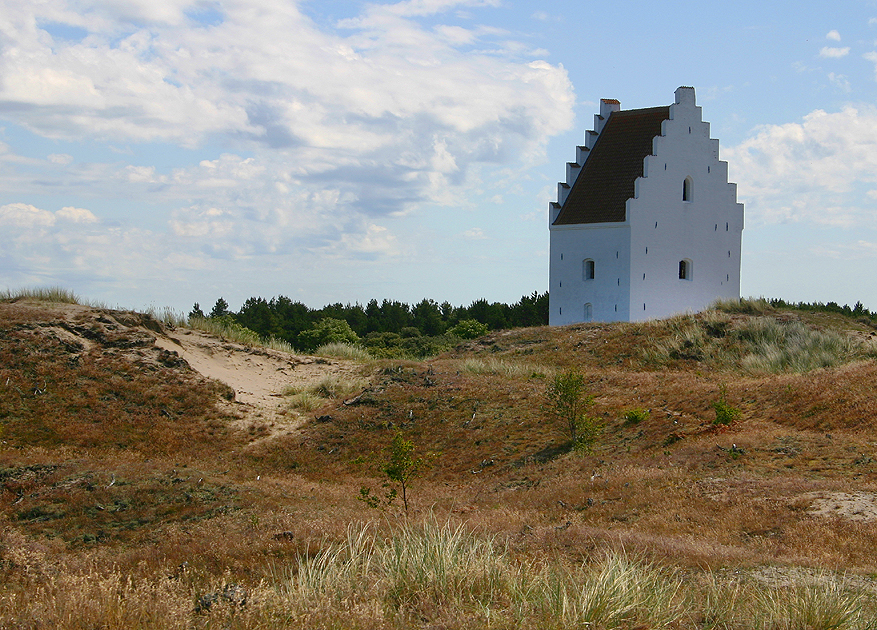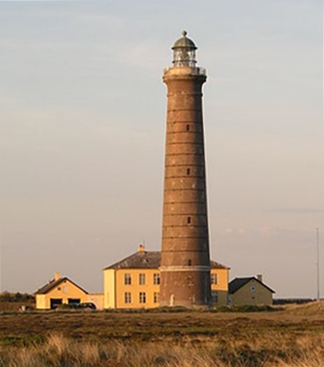|
Skagen's White Lighthouse
Skagen's White Lighthouse ( da, Det Hvide Fyr i Skagen) is a historic lighthouse just north of the town of Skagen in the far north of Jutland, Denmark. It was operational from 1747 to 1858 when it was replaced by Skagen Lighthouse.. History Designed by Philip de Lange, it was the first lighthouse in Denmark to be built of brick. The octagonal tower, initially in raw red brick, was Whitewash, whitewashed at the beginning of the 19th century. With a height of 21 m (69 ft), it is located at the junction of Fyrvej and Batterivej. The lighthouse was originally coal fired, the coal being hauled up through an internal shaft and placed in a fire basket. In 1835, Rapeseed, rapeseed oil replaced the coal and the lighthouse was fitted with a parabolic mirror. In 1858, the White Lighthouse was replaced by the Grey Lighthouse which was located 2 km further north on Skagen Odde. From 1871, the White Lighthouse was used as a signaling station to warn sailors of ice or of missing Lightvessel, ligh ... [...More Info...] [...Related Items...] OR: [Wikipedia] [Google] [Baidu] |
Lighthouse
A lighthouse is a tower, building, or other type of physical structure designed to emit light from a system of lamps and lenses and to serve as a beacon for navigational aid, for maritime pilots at sea or on inland waterways. Lighthouses mark dangerous coastlines, hazardous shoals, reefs, rocks, and safe entries to harbors; they also assist in aerial navigation. Once widely used, the number of operational lighthouses has declined due to the expense of maintenance and has become uneconomical since the advent of much cheaper, more sophisticated and effective electronic navigational systems. History Ancient lighthouses Before the development of clearly defined ports, mariners were guided by fires built on hilltops. Since elevating the fire would improve the visibility, placing the fire on a platform became a practice that led to the development of the lighthouse. In antiquity, the lighthouse functioned more as an entrance marker to ports than as a warning signal for reefs a ... [...More Info...] [...Related Items...] OR: [Wikipedia] [Google] [Baidu] |
Skagen
Skagen () is Denmark's northernmost town, on the east coast of the Skagen Odde peninsula in the far north of Jutland, part of Frederikshavn Municipality in Nordjylland, north of Frederikshavn and northeast of Aalborg. The Port of Skagen is Denmark's main fishing port and it also has a thriving tourist industry, attracting 2 million people annually. The name was applied originally to the peninsula but it now also refers to the town. The settlement began during the Middle Ages as a fishing village, renowned for its herring industry. Thanks to its seascapes, fishermen and evening light, towards the end of the 19th century it became popular with a group of impressionist artists now known as the Skagen Painters. In 1879, the Skagen Fishermen's Association was established with the purpose of facilitating the local fishing industry through the Skagensbanen railway, which opened as a narrow-gauged railway in 1890. The modern port of Skagen opened on 20 November 1907, and with ... [...More Info...] [...Related Items...] OR: [Wikipedia] [Google] [Baidu] |
Jutland
Jutland ( da, Jylland ; german: Jütland ; ang, Ēota land ), known anciently as the Cimbric or Cimbrian Peninsula ( la, Cimbricus Chersonesus; da, den Kimbriske Halvø, links=no or ; german: Kimbrische Halbinsel, links=no), is a peninsula of Northern Europe that forms the continental portion of Denmark and part of northern Germany. The names are derived from the Jutes and the Cimbri, respectively. As with the rest of Denmark, Jutland's terrain is flat, with a slightly elevated ridge down the central parts and relatively hilly terrains in the east. West Jutland is characterised by open lands, heaths, plains, and peat bogs, while East Jutland is more fertile with lakes and lush forests. Southwest Jutland is characterised by the Wadden Sea, a large unique international coastal region stretching through Denmark, Germany, and the Netherlands. Geography Jutland is a peninsula bounded by the North Sea to the west, the Skagerrak to the north, the Kattegat and Baltic Sea to the ... [...More Info...] [...Related Items...] OR: [Wikipedia] [Google] [Baidu] |
Skagen Lighthouse
Skagen Lighthouse ( da, Skagen Fyr), also known as Skagen's Grey Lighthouse (''Det Grå Fyr''), is an active lighthouse northeast of Skagen in the far north of Jutland, Denmark. Designed by architect Niels Sigfred Nebelong, it was brought into operation on 1 November 1858. Description Skagen's first lighthouse, the White Lighthouse (''Det Hvide Fyr''), designed by Philip de Lange and completed in 1747, was the first lighthouse in Denmark to be built in brick."Det Hvide Fyr i Skagen" ''Den Store Danske''. Retrieved 8 November 2013. The Skagen Lighthouse which replaced it consists of an unpainted round brick tower with a lantern and gallery, reaching a height of . The two-storey keeper's house to which it is attached is painted bright yellow. When it wa ... [...More Info...] [...Related Items...] OR: [Wikipedia] [Google] [Baidu] |
Philip De Lange
Philip de Lange (c. 1705 – 17 September 1766) was a leading Dutch-Danish architect who designed many different types of building in various styles including Dutch Baroque and Rococo. Early life and family Philip de Lange was probably born near Strasbourg and was trained as a mason in the Netherlands. He arrived in Copenhagen, Denmark, in 1729 where he quickly gained a reputation as an architect and master builder. Achievements De Lange created a large number of works of various types including civil and military buildings, mansions, country houses, warehouses, factories, churches and parks. The Dutch Baroque influence in his early work can, for example, be seen in the premises he built for Ziegler, the pastry cook, at Nybrogade 12 (1732). While initially he appears to have been struck by Ewert Janssen's earlier work, he soon seems to have been influenced by Elias Häusser and Lauritz de Thurah. Like Krieger, he participated strongly in creating fine bourgeois dwellin ... [...More Info...] [...Related Items...] OR: [Wikipedia] [Google] [Baidu] |
Whitewash
Whitewash, or calcimine, kalsomine, calsomine, or lime paint is a type of paint made from slaked lime ( calcium hydroxide, Ca(OH)2) or chalk calcium carbonate, (CaCO3), sometimes known as "whiting". Various other additives are sometimes used. Use as paint Whitewash cures through a reaction with carbon dioxide in the atmosphere to form calcium carbonate in the form of calcite, a type of reaction generally known as carbonation or by the more specific term, carbonatation. It is usually applied to exteriors; however, it has been traditionally used in interiors of food preparation areas, particularly rural dairies, because of its mildly antibacterial properties. Whitewash can be tinted for decorative use and is sometimes painted inside structures such as the hallways of apartment buildings. However it can rub off onto clothing to a small degree. In Britain and Ireland, whitewash was used historically in interiors and exteriors of workers' cottages and still retains something o ... [...More Info...] [...Related Items...] OR: [Wikipedia] [Google] [Baidu] |
Fire Basket
A fire basket is an iron basket in which wood can be burned to make a bonfire. Background During the Middle Ages fire baskets filled with sulfur were used to repel the Black Death. Currently the fire basket is used for enjoyment. In some countries the fire basket is used during Christmas in a Christmas pageant. Gallery Vonken naar de sterren.jpg, A fire in a basket Brasero de Pompeya.jpg, A fire basket from Pompeii See also * brazier External links * References Light fixtures Garden features Fireplaces Cooking vessels {{technology-stub ... [...More Info...] [...Related Items...] OR: [Wikipedia] [Google] [Baidu] |
Rapeseed
Rapeseed (''Brassica napus ''subsp.'' napus''), also known as rape, or oilseed rape, is a bright-yellow flowering member of the family Brassicaceae (mustard or cabbage family), cultivated mainly for its oil-rich seed, which naturally contains appreciable amounts of erucic acid. The term ''canola'' denotes a group of rapeseed cultivars which were bred to have very low levels of erucic acid and are especially prized for use as human and animal food. Rapeseed is the third-largest source of vegetable oil and the second-largest source of protein meal in the world. Description ''Brassica napus'' grows to in height with hairless, fleshy, pinnatifid and glaucous lower leaves which are stalked whereas the upper leaves have no petioles. ''Brassica napus'' can be distinguished from ''Brassica nigra'' by the upper leaves which do not clasp the stem, and from ''Brassica rapa'' by its smaller petals which are less than across. Rapeseed flowers are bright yellow and about across. T ... [...More Info...] [...Related Items...] OR: [Wikipedia] [Google] [Baidu] |
Skagen Odde
Skagen Odde, also Skagens Odde, sometimes known in English as the Scaw Spit or The Skaw, is a sandy peninsula which stretches some northeast and comprises the northernmost area of Vendsyssel in Jutland, Denmark."Skagen Odde" ''Den Store Danske''. Retrieved 4 October 2013. Skagen Odde is reported to be one of the largest spit systems in , created by a continuous process of marine sand and gravel deposition, moved in a north-east direction by s. The width of the spit varies from 3 to 7 km (2 to 4 mi). [...More Info...] [...Related Items...] OR: [Wikipedia] [Google] [Baidu] |
Lightvessel
A lightvessel, or lightship, is a ship that acts as a lighthouse. They are used in waters that are too deep or otherwise unsuitable for lighthouse construction. Although some records exist of fire beacons being placed on ships in Roman times, the first modern lightvessel was off the Nore sandbank at the mouth of the River Thames in England, placed there by its inventor Robert Hamblin in 1734. The type has become largely obsolete; lighthouses replaced some stations as the construction techniques for lighthouses advanced, while large, automated buoys replaced others. Construction A crucial element of lightvessel design is the mounting of a light on a sufficiently tall mast. Initially, it consisted of oil lamps that could be run up the mast and lowered for servicing. Later vessels carried fixed lamps which were serviced in place. Fresnel lenses were used as they became available, and many vessels housed them in small versions of the lanterns used in lighthouses. Some lightship ... [...More Info...] [...Related Items...] OR: [Wikipedia] [Google] [Baidu] |
Skagen's Vippefyr
Skagen's Vippefyr (sometimes referred to in English as Skagen's Lever Light) is a navigational light mechanism located in Skagen in the far north of Jutland. The original vippefyr, the first of its kind, was built in 1627. A faithful copy now stands on the same site. It replaced an earlier parrot light (''papegøjefyr'') and served until 1747 when the White Lighthouse was brought into operation. History In 1560, Frederick II of Denmark ordered his vassal Otte Brahe to establish lights at Skagen, Anholt and Kullen (in Sweden) to mark the main route through Danish waters from the North Sea to the Baltic. Initially wood and seaweed were used as fuel for the light, burnt on a tiled floor at the top of a wooden tower. Later, coal was used for all Danish lights as it provided better illumination but it often caused the wooden towers to catch fire. It was Jens Pedersen Grove from Helsingør who designed the vippefyr which consisted of a tipping mechanism where the coal could be burnt i ... [...More Info...] [...Related Items...] OR: [Wikipedia] [Google] [Baidu] |








